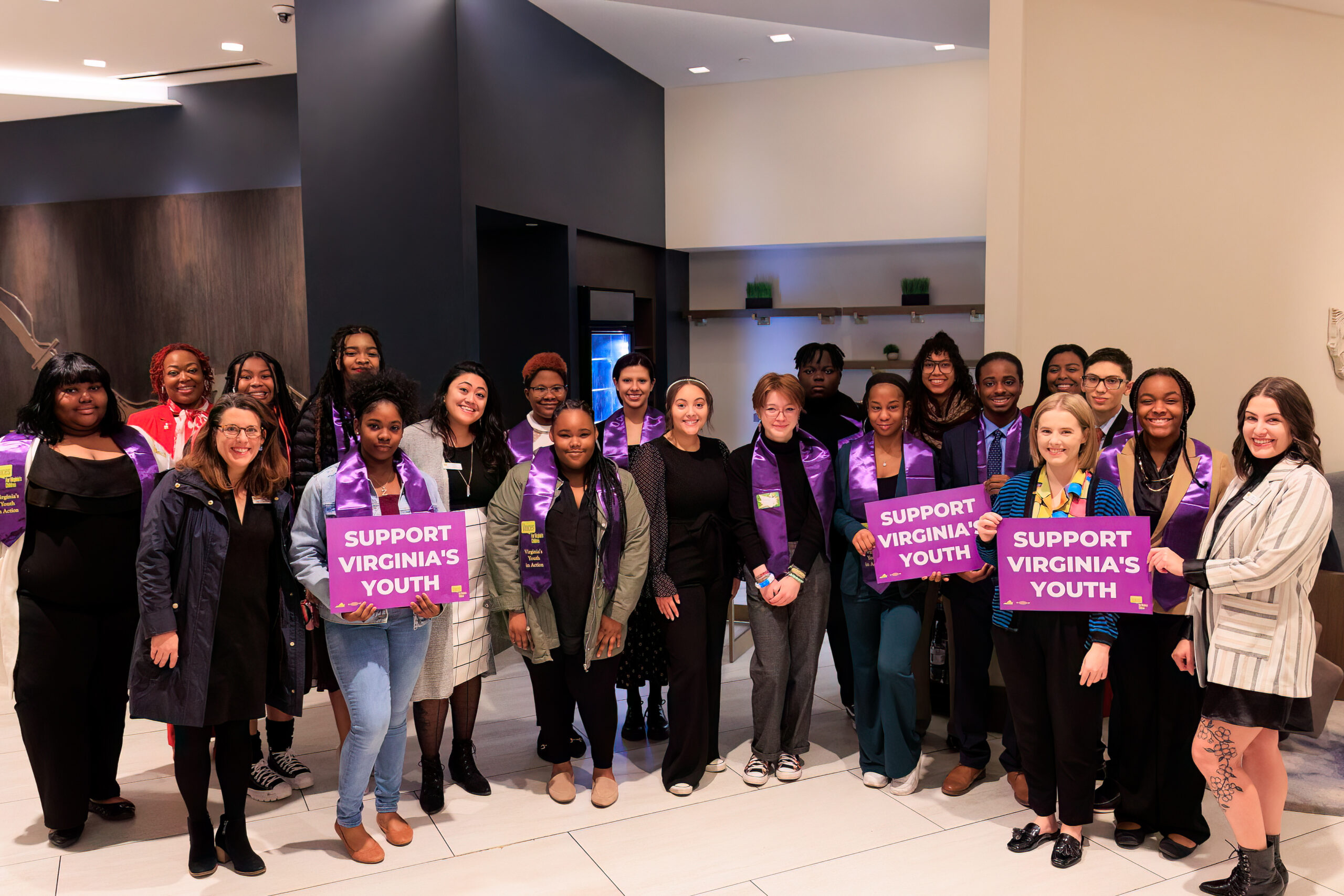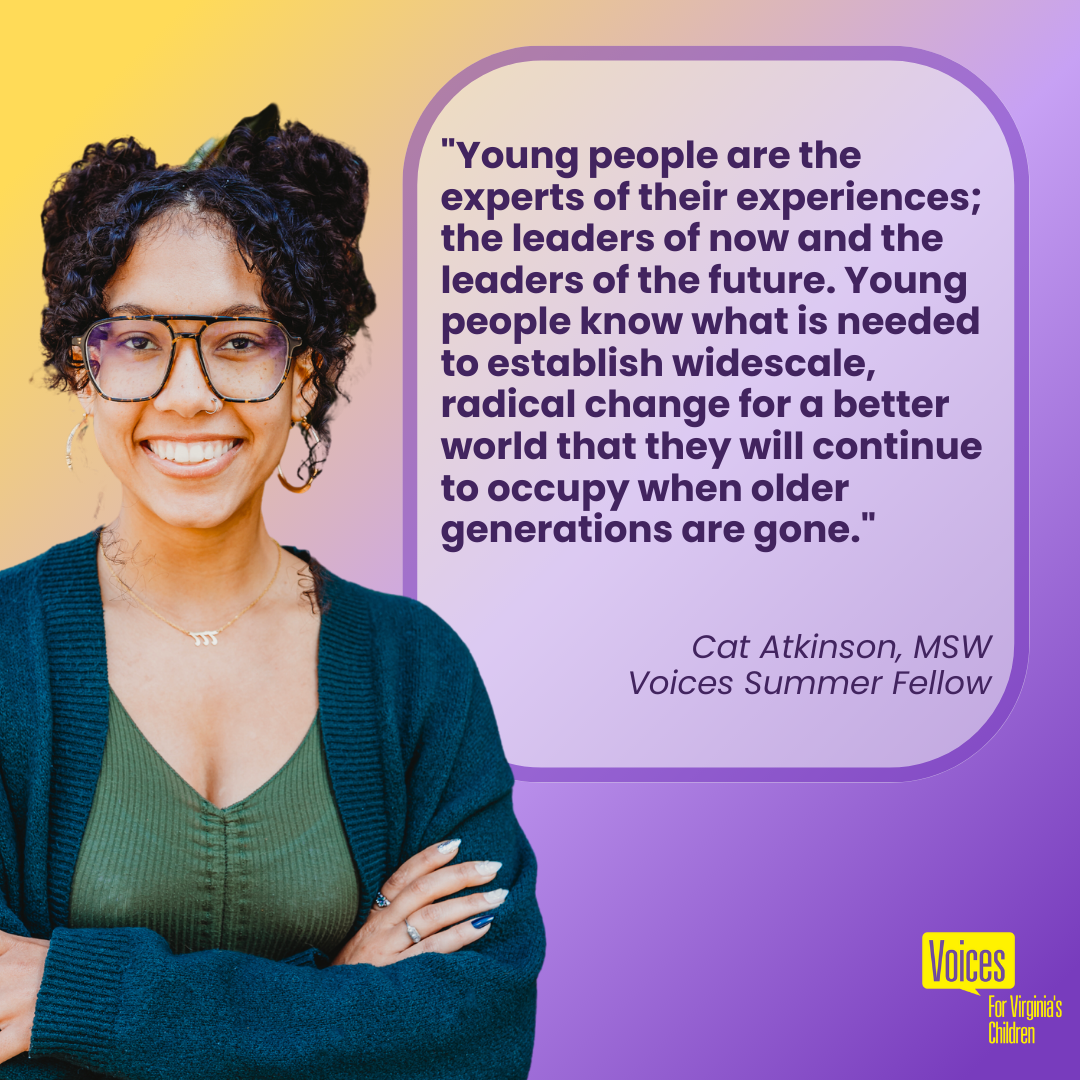

This blog was written by Voices Summer Fellow, Cat Atkinson, MSW, in collaboration with Virginia’s Youth in Action (VAYA) alum, Kayla Bravo.
Civic Engagement, or Political Engagement, is defined as actions that can be taken to improve a community through influence and participation in decision-making (Ballard, Borden, & Perkins, 2021). Civic actions encompass a wide range of participation strategies from community service to voting, from advocacy work to movement building. The various forms of civic engagement highlight the reality that anyone and everyone can be a part of the legislative and decision-making process if given the proper tools and knowledge to access an unfortunately elusive system. At Voices, we ground our advocacy work and youth programming within this reality and ensure that we provide a bridge for folks who are frequently left out of the political arena to civically engage with their lawmakers and within the lawmaking process in Virginia.
Many factors, including a person’s intersecting identities, their beliefs of whether their action will create change, their values and ideologies, sociodemographic statuses, and community conditions impact their interest and participation in civic actions (Chryssochoou & Barrett, 2017). For young people specifically, we also must consider familial and community civic participation, civic education, whether formal or informal, and geographical access. Kayla B., a young adult advocate, civic participant, and member of Virginia’s Youth in Action (VAYA) inaugural cohort, shares her experiences with civic immersion and engagement growing up in Arlington, VA.
“I am a first-generation Latine woman and first-generation college student. My parents had me at 19 – my mother was a high school dropout, and my father did not have the stability and resources to continue a formal education after high school. My father only just became an American citizen earlier this year but before then, neither of my parents were able to vote. My mother, who is still not an American citizen, had many issues regarding her immigration status during my childhood and was discouraged from exercising her political power as a constituent of her community. Moreover, because my parents (young, uneducated, blue-collar Hispanic immigrants) were so different from the other parents (old, educated, third generation+, white-collar, white people) of the children I went to school with, there was resistance on both parties to connect and participate in civic engagement together.
I was raised in Arlington, Virginia, an extremely wealthy county since it is a suburb of D.C. and was able to attend their public schools, which are considered top-rated Virginia schools. Arlington students are raised by a community that invests incredibly generous amounts of time, money, resources, nurturance, and support into their educational and career pursuits. I am so thankful to have been raised in such a community that was youth-led, where students were constantly staying engaged with their community’s issues and taking the agency to address these problems where they could.”
Historically, young people are drastically underrepresented in civic actions and left out of decision-making processes that impact them. It requires intentionality and care to ensure young people are empowered to engage civically because they must be at the table to make decisions on policies and practices that will impact their well-being. In social work, we are guided by the value that individuals are the experts of their own stories and therefore, are the experts in what is needed for them to thrive. This holds true for communities as well. Chryssochoou & Barrett (2017) highlight the importance of the collective identity of young people that bolsters their commitment to civic engagement. “It is through collective identifications that young people articulate common grievances and common goals that can politicize them and lead them to act together to change [a] situation” (p. 294). At Voices, we saw this clearly when engaging, uplifting, and supporting the amazing young advocates of VAYA. Coming from a wealth of different backgrounds, identities, experiences, family structures, and localities, this group of young advocates represented a collective of individuals who, despite their differences, shared the common grievance of a lack of mental health support for them in their communities and schools and the common goal to change this issue for themselves and other young people through advocacy by storytelling.
Kayla shares some examples of how she and fellow classmates in Arlington mobilized themselves to make changes in their community through civic actions.
“In my freshman year of high school, the school board had decided to redraw the school district lines that created a disproportionate trend where low-income students of color were placed in one school district and high-income white students were placed in another district. This decision made by the school board was met with outrage, especially by the students. A student wrote an open letter to the school board that addressed this unethical behavior and I remember it was all anyone would talk about for weeks. We were all so proud of our fellow youth for speaking out against the school board’s segregationist policy.
Students in my class year also worked to change our high school’s name. Formally known as Washington-Lee High School, named after Robert E. Lee, many students believed that this namesake was wrong and unrepresentative of the student body. Students created a coalition and attended many town hall meetings and collaborated with the Arlington County School Board to change our school’s name. I remember many students would watch the town hall meetings to hear our peers speak and were always very proud of them. After the course of a year, the students were able to vote for a new name (a practice I thought was very inclusive and engaging to students). I was in the first graduating class of Washington-Liberty High School.”
Kayla also shares how students would rally together to engage with presidential candidates that would visit their school, attend national and local protests, organize student walk-outs, and organize many fundraising projects for those in need such as GoFundMe and donation sites for protesting gear.
“I designed stickers where the proceeds went to Campaign Zero and a friend designed a tote bag where the proceeds went to the Black Lives Matter (BLM) movement.”
Juelich & Coll (2021) describe youth as engagement-based constituents in that they require mobilization or engagement by others to become involved in civic actions. For Kayla, it was her connection to an affluent white community that poured resources into their youth and who raised their youth with “strong values of expression, inclusion, and advocacy.” Kayla continues, “We were supported when we took agency in issues that mattered to us.” However, more importantly, she states that she “learned to value and exercise my political power from following the examples of other youth, NOT ADULTS. Communities that nurture youth voice [will] raise youth who are proactive and engaged. This way, we learn to connect with youth as leaders and experts regardless of adult trust or confidence in our abilities and vision.”
At Voices, we focus our youth and young adult programming on building community, centering healing in storytelling, and uplifting the already impactful and passionate work of young people in our state. Innately, our hope is that we can intentionally build a space that immerses youth in civic action such as Kayla had growing up in her community, and therefore, building that bridge from the community to the legislature. We had a vision that Virginia’s Youth in Action would create a line for young people to gain access to the civic action of legislative advocacy through learning about the Virginia legislative process, how power and privilege permeate within the institution and the intersection of their stories to the legislative process at large. What we experienced was even more extensive.
When developing our youth programming, we intentionally ensure information is accessible by cutting out the jargon and making the content digestible to different levels of knowledge and understanding. We focus on high-level context with relatable examples that are empowering, practical, and radical. Consideration of content, paired with the recognition of the day-to-day pressures and expectations of young people from their schools, their hobbies, their families, and their time to rest, are just two shifts that other organizations can make when engaging young people civically. We are deliberate in scheduling meetings or engagement times with young people outside of standard office hours and on weekends. We understand that it is our job to come to these changemakers and provide them with our services, rather than hoping they can come to us when their schedules are not designed the same as ours.

At Voices for Virginia’s Children, we ensure that we utilize our position to also uplift the voices of Virginia’s young people and their living experiences. Not just within our organization, but nationally, we are experiencing a pivot in how young people are represented and viewed in change work. Young people have always been at the forefront of activism and widescale change. However, the older generations have been vastly unprepared to accept this due to the normalcy of underestimating young people’s knowledge, autonomy, and truths. The pivot we are seeing and experiencing now is a readiness and willingness by adults and (some) people in power, to listen to and be led by young people. Young people are the experts of their experiences; the leaders of now and the leaders of the future. Young people know what is needed to establish widescale, radical change for a better world that they will continue to occupy when older generations are gone.
So why not ensure these amazing young people are occupying spaces that educate adults about their needs? Why not ensure young people are at the forefront of all policy changes in schools? Why not ensure young people are equipped to engage civically at the polls? Why not ensure that all adults are prepared to let go of the societal norms rooted in ageism, to sit back and listen to younger generations who will have to continue living in the world created by older generations? This is a call for adults in civic spaces, legislative spaces, advocacy spaces, social work, change work, etc., to think about how they engage with young people. Are you ready to take a backseat and let young people lead us? Because young people will continue to work, advocate, fight, take up space, and use their voices to enact change, whether given permission or not.
We affirm what Kayla reiterates, “Engagement is key to feeling included, respected, understood, and fulfilled!!”

Kayla Bravo is a fourth-year undergraduate student at Virginia Commonwealth University studying both political science and philosophy. She also works as a youth advocate. Most recently, she served as a member of Virginia’s Youth in Action advocacy council created by Voices for Virginia’s Children.
Cat Atkinson, MSW, is a social worker practicing in the Richmond area with living expertise as a bi-racial transracial adoptee and an individual living with mental health challenges. She is a former Voices intern and current summer fellow.